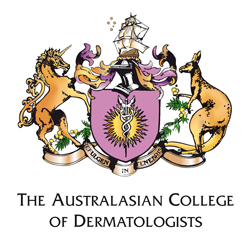Reactive Angioendotheliomatosis in the setting of Antiphospholipid Syndrome
Australasian Journal of Dermatology
Volume 44, Issue 2, pages 151–155, May 2003

A 31-year-old man with systemic lupus erythematosus and antiphospholipid syndrome developed erythematous purpuric plaques distributed over the lower chest, abdomen and upper thighs. Biopsy of lesional skin revealed intravascular proliferation of endothelial cells with associated microthrombi formation. The histological pattern was consistent with reactive angioendotheliomatosis, a rare reactive pattern seen associated with disparate medical conditions. The pathogenesis of the reactive angioendotheliomatosis in our patient was suspected to be related to his procoagulant state; thrombi formed despite a therapeutic international normalized ratio while on warfarin. His lesions began to resolve with the cessation of warfarin and commencement of subcutaneous enoxaparin, oral clopidogrel and oral aspirin. The skin biopsy findings were pivotal in influencing the change of therapy in this patient and decreasing his immunosuppression.
Thai, K.-E., Barrett, W. and Kossard, S. (2003), Reactive angioendotheliomatosis in the setting of antiphospholipid syndrome. Australasian Journal of Dermatology, 44: 151–155. doi: 10.1046/j.1440-0960.2003.00670.x




